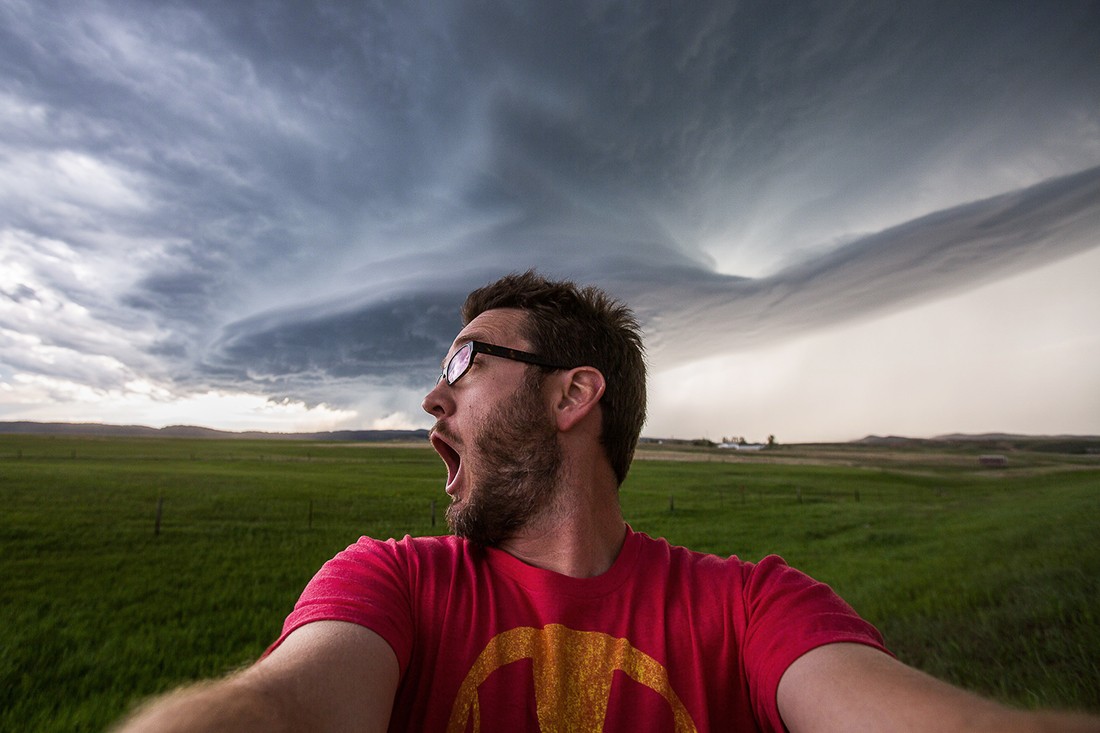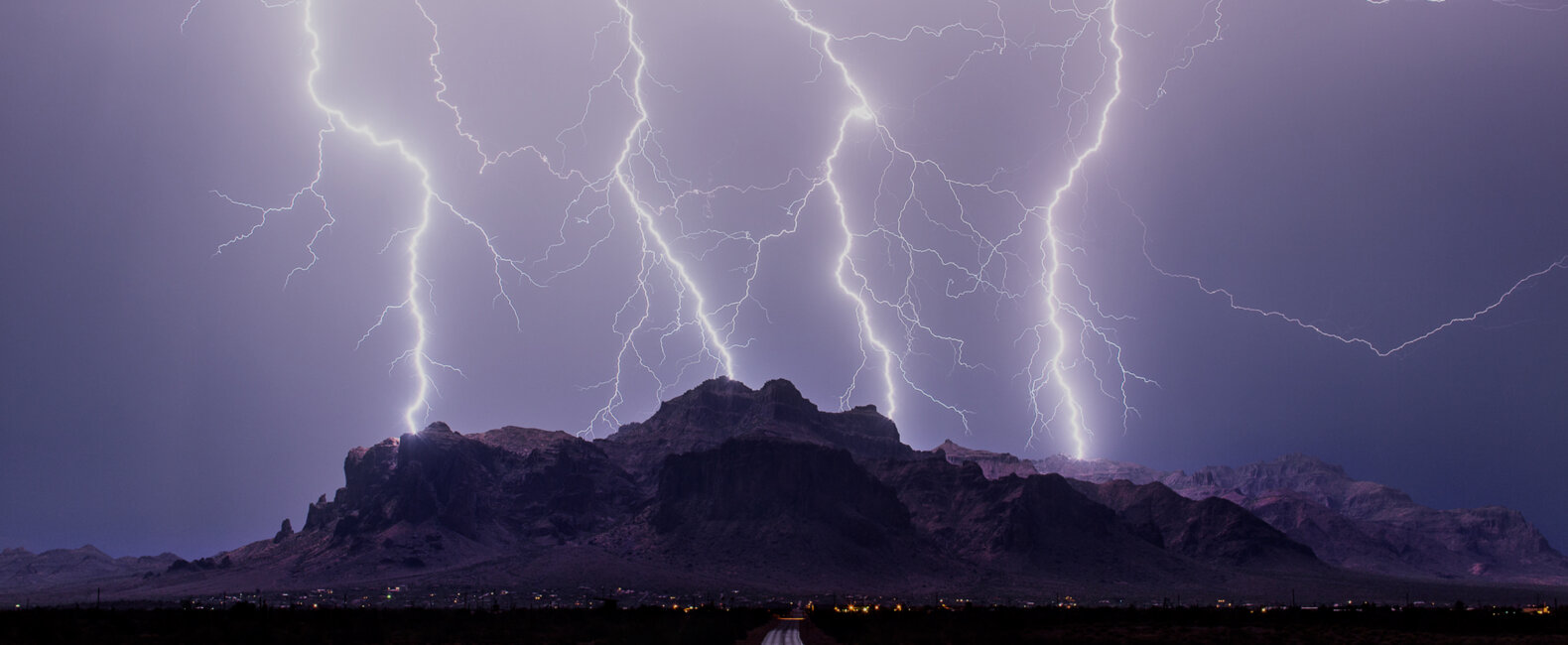Some images are great because they capture the world we all recognize. Others are great because they show us the world like we’ve never seen it. Mike Olbinski, storm photographer and time-lapse filmmaker, falls firmly into the second category. His work seems in this world but not of it. Clouds inflate to colossal heights in seconds. Rain falls like water squeezed out of a sponge. These storms have character. They have drama.Olbinski’s films show us our world but with a super-human perspective of time. Maybe this is what storms look like to God.
“It’s a bit like wrangling a cow,” Mike told us. “As soon as you’ve gotten it, you immediately let it go and chase the next one. You never get tired of it. You go, go, go all the time…it’s an addiction.”
Time-lapses have long been used to help us better understand the botanical world, the geological world, the meteorological world, the astrological world. But at their best, time-lapses help us understand our place in a universe that is rarely best seen at 24 frames per second.
Mike Olbinski has risked his life and dedicated his career to show us weather like we’ve never seen it. We recently talked to him about how, and why, he does it.

You get me in a storm, and I will scale a barbed wire fence and run into the middle of a cornfield just to get a shot of lightning.
Musicbed: Are you a gambling man?
Mike Olbinski: Not really.
Storm photography seems like the most gambly form of photography.
It’s funny. I go on a road trip with this group of guys every January. We’re all in an RV and we’re just exploring. I’m the older one in the group, and I’m a lot more cautious. They’re going into abandoned houses with No Trespassing signs, and I’m always the one warning them that somebody is going to show up with a shotgun and shoot them. So I feel like I’m a pretty cautious guy. But you get me in a storm, and I will scale a barbed wire fence and run into the middle of a cornfield just to get a shot of lightning. I don’t care what’s happening around me. I don’t care about the consequences. One of my shots from last year was from west of Phoenix, where the lightning strikes were hitting less than half a mile away. I ran to the middle of an overpass, over I-10, where trucks were flying by me less than three feet away. And in the middle of this, all I’m thinking is, Oh man, I’ve got the perfect composition. All of a sudden these lightning bolts streaked across the sky, and it became one of my favorite shots I’ve ever taken. So yeah, when I’m chasing, I guess I’m a gambling man. But in the rest of my life, not so much.
Are you scared of storms?
I don’t remember ever being afraid of them. I just remember loving them. Here in Phoenix, we don’t have dangerous tornados. We don’t really get hail. We just have lightning, and for some reason we all ignore it.
Is that why you take pictures of it?
Lightning photography is fascinating to me because no one can ever get the same shots you get. If you’re somewhere and a lightning bolt strikes, you’re probably the only person who is ever going to get that shot. Lightning is constantly different. You’re never like, “Oh, that same old lightning bolt again.” You can shoot the Grand Canyon only so many times, but lightning will always be new.
The first shots of lightning I ever got were with this crappy little camera. It shot three shots a second, or something like that, and I somehow got this crazy shot of three bolts racing across the sky. I sent it in to one of the local television stations, and they showed it on the news that night. After that, I was hooked.
One of the cool things about lightning photography is that your camera picks up all this stuff your eyes can’t process. And there’s so little you can control. One time I was down in southeast Arizona at maybe 1:30 in the morning, and I opened my shutter for 20 or 30 seconds at the exact time that three cars raced by and five lightning bolts struck in the distance. People ask me if it’s a composite. And I’m like, “No! This all happened in 30 seconds!” But nobody else could ever get that shot. They could wait in that spot for years and years, and they’d never get it.

What do you take pride in as a storm photographer/filmmaker?
I like to think that I see things in the sky that other people don’t see. The way the clouds are moving. The motion. Sometimes I see other people’s photos of clouds, and I feel like they’re just boring clouds. I take a lot of pride in my ability to get to a storm and know how to get a good photo out of it. But like you said, it’s a gamble. Sometimes your luck runs out. You just hope the storm does something. That’s the luck part. But there is a lot of skill in knowing where to put yourself. You develop sort of a sixth sense, and mine is getting better year after year.
One of the things I’m best at, though, is looking at my work and knowing that it’s not always super great. That it’s nowhere near what some of these guys are doing. Which is helpful. I think a lot of photographers have no clue where they stand. One thing that’s really helped my work is realizing there are people who are better than I am and knowing I can learn from them.
It’s easy to think that not liking your work is a bad thing. But really, a person’s ability to see what’s bad about his work means he’s going to get better. If you can’t see it, you can’t improve.
Exactly. Sometimes I hear people expressing their frustration because they’re not on the front page of 500px. They don’t understand why their photo isn’t up there. I want to tell them, “It’s because you’re not that good yet. Those other guys are better than you.” If you can’t see it for yourself, then no one can explain it to you.
Sometimes I worry I’m going to look back at old work and really love it.
Totally. Sometimes I look back at my photos from a few years ago, and I feel like they’re great. I’m like, Am I still at that level? Have I stopped growing? Sometimes I feel like that too.
But some of that early stuff is good because I had more energy, more nervousness. It pushed me to work harder. For example, in addition to shooting storms, I’ve also shot something like 100 weddings. Now that I’ve shot so many, it can get kind of routine. You aren’t nervous, you know what you’re doing, and sometimes that means you’re not pushing yourself to do your best work.
Maybe that’s one of the good things about storm photography. It can kill you. So that forces you to stay edgy.
Oh yeah. For sure.

A person’s ability to see what’s bad about his work means he’s going to get better. If you can’t see it, you can’t improve.
At some point you started experimenting with time-lapses. How did that happen?
It was back in 2011. It was early in the monsoon season, and for some reason I had this idea that I could time-lapse a dust storm in a way that people weren’t used to seeing. A lot of times you see dust storms from shaky helicopter cameras. But I thought I could capture it in a way that showed what it really looks like.
My first time-lapse was filmed on July 4th and 5th. Someone texted me that a dust storm was coming into town, and it just happened to be the most incredible dust storm any of us had ever seen. I went to the top of this parking garage to capture it, and I didn’t do a very good job. Looking back now, I hate myself for the stuff I did. I shot JPEG. I shot with auto white balance. I did five-second intervals instead of every second. I even moved the camera at one point to get a different angle.
But people watched it and it went viral. They loved it. My mistakes didn’t matter because the dust storm was so incredible. People started licensing it. Within a week, I got a call from Al Gore’s office, National Geographic, and a whole bunch of other people. I even licensed it to a local air conditioning company here in Phoenix who used it to make a commercial about cleaning your air conditioner after a dust storm. It was the first time I made money on this stuff. So that’s when I started getting into time-lapse.
A few years later, I went storm chasing with some guys, and we happened upon one of the most incredible super cells. Probably one of the best of the year. There are just one or two epic super cells a year, and you have to be lucky to catch them. So I put a time-lapse together, thinking, Hey, this might be pretty great. And it also went viral. It was the number one time-lapse video on Vimeo in 2013. I couldn’t believe it. That one ended up in movies like Thor 2, Lamborghini commercials, so many things.
I’ve made money with these things. But I also love making them. It’s my passion. I want to capture the essence and beauty of storms, and put it to music that evokes emotion. Something about those two things ⎯ music and storms ⎯ really connect with people. I’m trying to tell stories with these storms. My last film was 10 minutes long. That’s a long time to watch storms. But I’m learning how to hold people’s attention, how to capture what fascinates them. I am trying to create drama through motion.
Is time-lapsing storms a way of subduing something that we’re otherwise helpless against?
It’s like trying to capture this one moment so that later you can say, “I caught this amazing storm in a way that no one else could.” So yeah, it’s a bit like wrangling a cow. As soon as you’ve gotten it, you immediately let it go and chase the next one. You never get tired of it. You go, go, go all the time. That drive, that passion ⎯ it’s an addiction. And ultimately that’s what leads you to doing this stuff at a higher and higher level.
If you’re going to storm chase, you have to really, really want to storm chase. You have to love it. I didn’t get into this because I wanted to be like the guys on Storm Chasers. I got into it because I love weather. I love storms. And that’s the most important thing. You have to figure out why you love what you’re doing. You have to do what you love.
Mike’s footage has been seen across multiple platforms, in both commercials and major motion pictures. His work is available for licensing with our sister company Filmsupply.


















































































